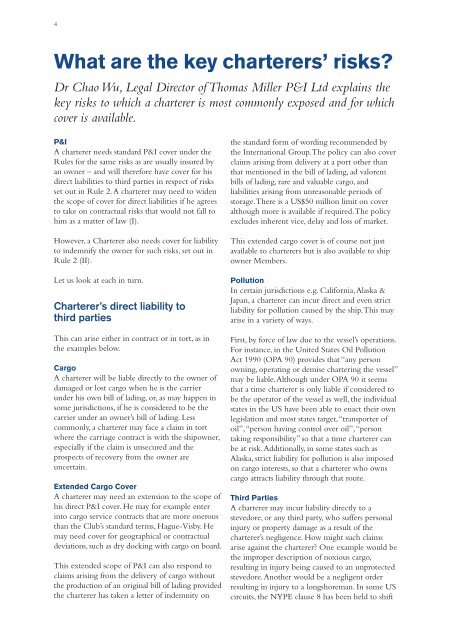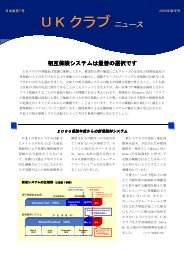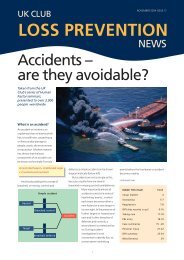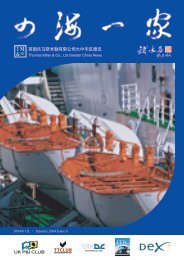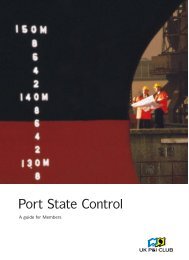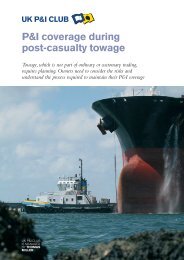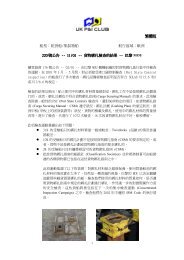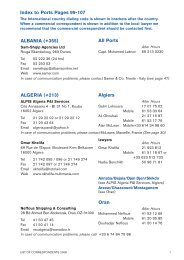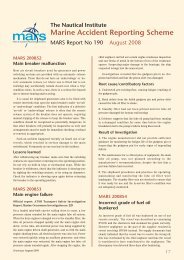Charterers' Liability Cover - UK P&I Members Area
Charterers' Liability Cover - UK P&I Members Area
Charterers' Liability Cover - UK P&I Members Area
You also want an ePaper? Increase the reach of your titles
YUMPU automatically turns print PDFs into web optimized ePapers that Google loves.
4What are the key charterers’ risks?Dr Chao Wu, Legal Director of Thomas Miller P&I Ltd explains thekey risks to which a charterer is most commonly exposed and for whichcover is available.P&IA charterer needs standard P&I cover under theRules for the same risks as are usually insured byan owner – and will therefore have cover for hisdirect liabilities to third parties in respect of risksset out in Rule 2. A charterer may need to widenthe scope of cover for direct liabilities if he agreesto take on contractual risks that would not fall tohim as a matter of law (I).However, a Charterer also needs cover for liabilityto indemnify the owner for such risks, set out inRule 2 (II).Let us look at each in turn.Charterer’s direct liability tothird partiesThis can arise either in contract or in tort, as inthe examples below.CargoA charterer will be liable directly to the owner ofdamaged or lost cargo when he is the carrierunder his own bill of lading, or, as may happen insome jurisdictions, if he is considered to be thecarrier under an owner’s bill of lading. Lesscommonly, a charterer may face a claim in tortwhere the carriage contract is with the shipowner,especially if the claim is unsecured and theprospects of recovery from the owner areuncertain.Extended Cargo <strong>Cover</strong>A charterer may need an extension to the scope ofhis direct P&I cover. He may for example enterinto cargo service contracts that are more onerousthan the Club’s standard terms, Hague-Visby. Hemay need cover for geographical or contractualdeviations, such as dry docking with cargo on board.This extended scope of P&I can also respond toclaims arising from the delivery of cargo withoutthe production of an original bill of lading providedthe charterer has taken a letter of indemnity onthe standard form of wording recommended bythe International Group. The policy can also coverclaims arising from delivery at a port other thanthat mentioned in the bill of lading, ad valorembills of lading, rare and valuable cargo, andliabilities arising from unreasonable periods ofstorage. There is a US$50 million limit on coveralthough more is available if required. The policyexcludes inherent vice, delay and loss of market.This extended cargo cover is of course not justavailable to charterers but is also available to shipowner <strong>Members</strong>.PollutionIn certain jurisdictions e.g. California, Alaska &Japan, a charterer can incur direct and even strictliability for pollution caused by the ship. This mayarise in a variety of ways.First, by force of law due to the vessel’s operations.For instance, in the United States Oil PollutionAct 1990 (OPA 90) provides that “any personowning, operating or demise chartering the vessel”may be liable. Although under OPA 90 it seemsthat a time charterer is only liable if considered tobe the operator of the vessel as well, the individualstates in the US have been able to enact their ownlegislation and most states target, “transporter ofoil”, “person having control over oil”, “persontaking responsibility” so that a time charterer canbe at risk. Additionally, in some states such asAlaska, strict liability for pollution is also imposedon cargo interests, so that a charterer who ownscargo attracts liability through that route.Third PartiesA charterer may incur liability directly to astevedore, or any third party, who suffers personalinjury or property damage as a result of thecharterer’s negligence. How might such claimsarise against the charterer? One example would bethe improper description of noxious cargo,resulting in injury being caused to an unprotectedstevedore. Another would be a negligent orderresulting in injury to a longshoreman. In some UScircuits, the NYPE clause 8 has been held to shift


